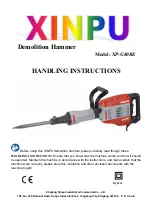
For questions or concerns, e-mail [email protected], visit www.ussolid.com, or
call (800) 209-4177
Soybeans
Soybeans contain little oil. 500g of local soybeans contains 60-90g
of oil; transgenic soybeans contain 90-125g of oil. You can refer to
the steps to press peanuts for hot pressing, namely, heat soybeans
till their skins crack and then press them.
Rapeseeds
There are two kinds of rapeseeds, winter and spring, both of which
contain 30%-40% oil in most cases. Pick fresh and plump rape
-
seeds. The time of heating should be reduced since rapeseeds are
a small grain. Oil extraction rates of different rapeseeds in different
regions are quite different. Please refer to the method for pressing
camellia seeds. Make sure to drain off any water before pressing.
Safflower Seeds and Fructus Cannabis
The shell of safflower seeds or fructus cannabis is very thick and
hard. It is best to shell them before pressing. If they can’t be
shelled, make sure to heat the raw materials and press them when
they’re still hot, as suggested by the “hot pressing” method intro-
duced above.
Turn on the machine for 30 minutes to heat it up first and then turn
on the pressing switch. Put in a small amount first and fill the hop
-
per after a normal amount of slag is detected. Press them one
time, and if it backs up, clean out the pressing chamber and start
over.
X. Factors Affecting Oil Extraction
Oil extraction rates of different raw materials may vary based on
batches, production areas, varieties, grain sizes, harvest times,
storage periods, storage environments, extraction technologies,
whether uncultivated or artificially cultivated, imported or locally
produced.
1. Varieties of Raw Materials: the longer the growing period, the
higher the oil content. Those produced in cold areas contain more
oil, as do transgenic ones.
2. Storage and Plucking Time: the longer the storage time, the low-
er the oil extraction rate.
3. Storage Temperature: the higher the storage temperature, the
lower the oil extraction rate.
Summary of Contents for USSOILP1
Page 20: ......






































